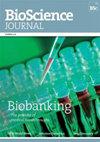铝处理对油棕幼苗代谢的影响
IF 0.6
4区 农林科学
Q3 AGRICULTURE, MULTIDISCIPLINARY
引用次数: 0
摘要
由于降雨和高温,亚马逊土壤的来源物质发生了变化,碱性阳离子也发生了浸出。这导致了深层、贫瘠和酸性土壤。酸性土壤中存在的铝通过抑制根系形成、酶反应、吸收、运输和养分利用来损害植物的生长和发育。本研究旨在评价铝剂量对油棕代谢的影响。这项研究是在亚马逊联邦农村大学的温室里进行的。实验设计是随机的,有五个重复,其中给予0、10、20、30和40mg L-1氯化铝(AlCl3.6H2O)的剂量。分析了油棕叶和根中的电解质渗漏、硝酸盐、硝酸还原酶、游离铵、可溶性氨基酸、脯氨酸含量和可溶性蛋白质。根中铝含量最高。40 mg L-1的AlCl3处理增加了根中的电解质渗漏、硝酸盐、铵和脯氨酸浓度,以及叶和根中的氨基酸浓度。此外,在根中观察到硝酸还原酶活性降低。本研究表明油棕对铝的毒性具有耐受机制。本文章由计算机程序翻译,如有差异,请以英文原文为准。
The effect of aluminum treatment on metabolism in oil palm seedlings
Due to rainfall and high temperatures, the Amazonian soil undergoes changes in its source material and leaching of base cations. This results in deep, infertile, and acidic soil. Aluminum present in acidic soil impairs plant growth and development by inhibiting root formation, enzymatic reactions, absorption, transport, and nutrient utilization. This study aimed to evaluate the effects of aluminum dosage on the metabolism of the oil palm Elaeis guineensis Jacq. The study was conducted in a greenhouse at the Federal Rural University of Amazonia. The experimental design was randomized, with five replications, in which dosages of 0, 10, 20, 30, and 40 mg L-1 aluminum chloride (AlCl3.6H2O) were administered. Electrolyte leakage, nitrate, nitrate reductase, free ammonium, soluble amino acids, proline content, and soluble proteins were analyzed in the leaves and roots of the oil palm. The highest concentration of aluminum was found in the roots. AlCl3 treatment at 40 mg L-1 increased electrolyte leakage, nitrate, ammonium, and proline concentrations in the roots, and amino acid concentrations in both the leaves and roots. Furthermore, a decrease in nitrate reductase enzyme activity was observed in the roots. This study demonstrates that the oil palm has mechanisms of tolerance to aluminum toxicity.
求助全文
通过发布文献求助,成功后即可免费获取论文全文。
去求助
来源期刊

Bioscience Journal
Agricultural and Biological Sciences-General Agricultural and Biological Sciences
CiteScore
1.00
自引率
0.00%
发文量
90
审稿时长
48 weeks
期刊介绍:
The Bioscience Journal is an interdisciplinary electronic journal that publishes scientific articles in the areas of Agricultural Sciences, Biological Sciences and Health Sciences. Its mission is to disseminate new knowledge while contributing to the development of science in the country and in the world. The journal is published in a continuous flow, in English. The opinions and concepts expressed in the published articles are the sole responsibility of their authors.
 求助内容:
求助内容: 应助结果提醒方式:
应助结果提醒方式:


